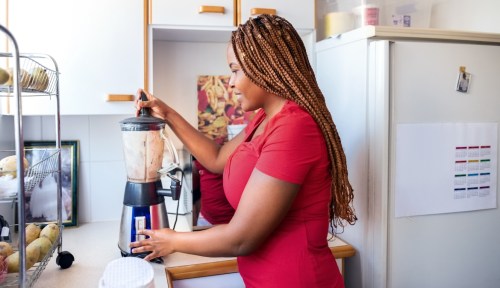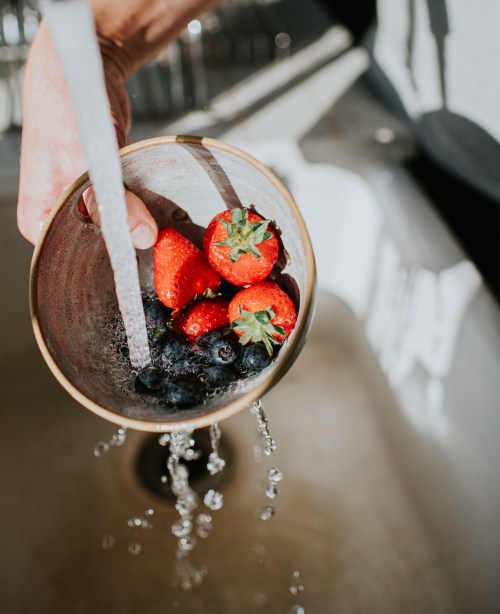As tidy as I may be *most* of the time, there are certain things I definitely don’t look forward to cleaning. Toilets and trash bins land at the top of that list, naturally. But maybe less universal so, too, do blenders. Still, I know I’m not the only one who’s ever whipped up a protein-packed green smoothie only to delay the inevitable soak and scrub, being left with a crusty, gunky, smelly mess.
Experts in This Article
a food safety expert and corporate director of technical training and consulting at Microbac Laboratories
To get ahead of this fairly gross but fortunately avoidable issue, we asked food safety expert Trevor Craig, corporate director of technical training and consulting at Microbac Laboratories, how to clean a blender correctly once and for all.
The risks of not thoroughly cleaning your blender
If you need any convincing that your blender could use some cleaning TLC, know this: The appliance—as well as other kitchen tools like can openers and cutting boards—are a common source of contamination in the kitchen, according to the University of Rochester Medical Center. Blenders in particular (and food choppers and processors, come to think of it) are designed with plenty of nooks and crannies in which food stuff can collect… and a lot of us likely aren’t deep cleaning within the base’s rims and under those blades. Yet the remnants of an inadequately cleaned blender aren’t just unseemly; they may also end up lurking long enough for your next shake and the ones thereafter.
“Just like we need nutrients and energy, so do dangerous bacteria,” Craig explains. “Even if it’s not visible to you, food residue can provide that important nutrition to bacteria, which can quickly grow and contaminate your blender and the food you make in it.” What’s more, he says that under certain conditions (i.e., damp and dark environs), bacteria can double in as little as minutes to hours. “It just takes a few pathogenic bacteria to cause human illness,” he warns. “Plus, it’s just gross to think about.”
5 tips to clean your blender correctly
Whether you mix up a protein shake for breakfast every morning, have fallen for that viral cottage cheese bread, or adore blender soups, you’ll want to be sure to heed Craig’s blender cleaning tips below to prevent pathogens from being an unwelcome ingredient in your meals.
1. Blend some warm, soapy water
This swift and simple hack has completely revolutionized my own smoothie game. Best of all, it takes only a few seconds, so there are really no excuses not to clean your blender immediately after use. Just think of all the extra elbow grease you’ll save from scrubbing off gunk that’s been left to crust for a few hours, overnight, or (the horror!) a few days.
On the soap front, Craig says a little dab’ll do ya. “You only need a few drops of soap as running the blender is going to agitate to a lot of bubbles,” he says.
2. Make a DIY disinfectant
If soap isn’t enough to cut through grease and grime, Craig suggests opting for a more effective disinfecting solution. “You can run with a mixture of vinegar and water to help break up any films or oil residue,” he explains. A 1:1 ratio should do the trick to deep clean this kitchen appliance.
3. Run it through the dishwasher (as advised)
“Of course, if you want a deep clean, you can take apart most blenders and put them in the dishwasher if they are safe to do so,” says Craig. Be sure to read the user guides provided by your blender brand and model. (For quick reference, NutriBullet blender parts—save for the motor base and extractor blade—are dishwasher-safe; just be sure to load it on the top rack. So, too, are Vitamix lids, lid plugs, centering pads, and tampers.)
“When placing [blender parts] in the dishwasher, make sure you take them out quickly and dry them, or turn them so they have no water stuck in them,” Craig advises. Failing to do so may end up reversing any of the cleaning you just did. Remember: Bacteria thrives in warm and dank environments, so any post-dishwasher heat and moisture can lead to the so-called danger zone for bacteria to grow. “Be careful of blades, and make sure to dry them so they don’t rust or grow dull,” he adds.
4. Hand wash, and invest in the right tools, as needed
Not all blenders are suitable for the dishwasher. For instance, BlendJet advises against putting their products in the dishwasher or even submerging their blenders fully in water. With blenders that aren’t dishwasher-safe, your best bet is to follow the first and second tips above. In addition, you’ll get closer to squeaky clean by fully disassembling all parts and investing in a sturdy dish brush. Craig finds that his small blender is harder to clean than bigger ones since its parts are harder to reach. In this case, a smaller cleaning brush can sweep in to handle those hard-to-miss spots. And don’t forget to dry all parts fully.
Depending on the type of blender you use, your appliance may come with small parts that need to be individually cleaned and even replaced every so often. The Nutri Ninja Pro, for example, is equipped with a gasket—or rubber sealing ring—inside the blade cap. This piece can get grimy, and even harden or break over time. Washing out the blender up with soap and warm water is usually enough to reach the blender, but the ring benefits from some extra care one to two times per month, according to a representative for Ninja. To remove the gasket, use a tweezers to take it out from the blade cap. Soak the ring in warm water with vinegar and a little bit of dish soap. Rinse the ring and allow it to dry before placing it back within the blade cap. The representative advises against using bleach for this piece.
5. Don’t forget to sanitize your blender base
While blender vessels and attachments need the most thorough cleaning, don’t neglect to clean your blender base, too. After all, it’s a high-touch surface in your kitchen that can also harbor food particles and bacteria. In tandem with a clean sponge or dish towel, a multi-use kitchen cleaning spray should do the trick. Again, it’s best to err on the side of caution by consulting your blender manual’s recommendations.
Sign Up for Our Daily Newsletter
Get all the latest in wellness, trends, food, fitness, beauty, and more delivered right to your inbox.
Got it, you've been added to our email list.











